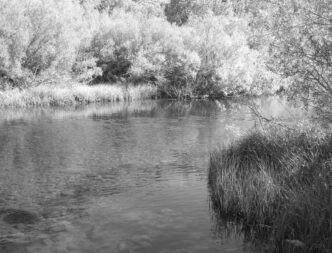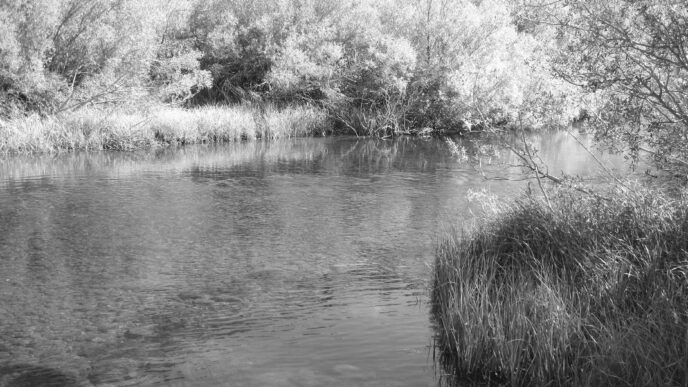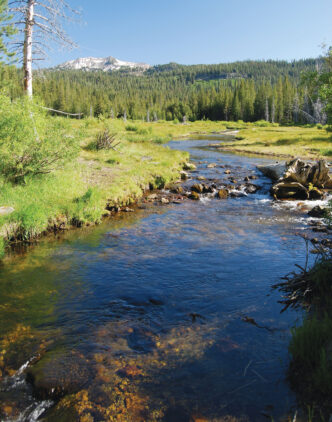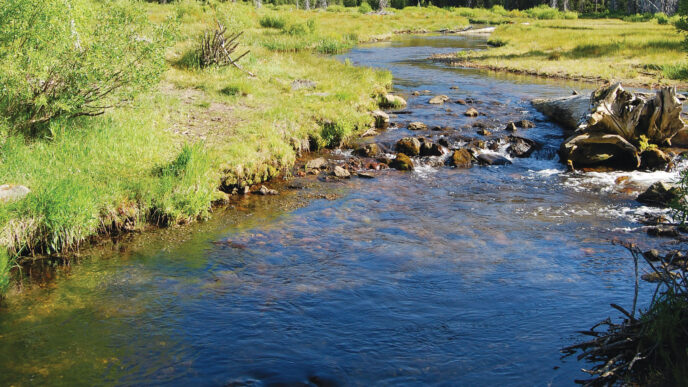Henry David Thoreau’s famous advice in Walden, “Simplicity, simplicity, simplicity . . . let your affairs be as two or three, and not a hundred or a thousand,” should be your watchword when selecting and putting together cooking gear, spices, and condiments for a camping trip, a week in a mountain cabin, in your trailer, RV, or a vacation rental at a lake or on the beach. The benefits of simplicity manifest themselves during pre-trip preparation and packing, cooking in camp, dishwashing, and the dreaded pack-up, departure, and return home. Yet simplicity doesn’t mean that great meals, even gourmet repasts, can’t be prepared and enjoyed in fabulous settings. The real dilemma is deciding how much or how little to take with you. There is a fine line between having the tools to prepare memorable meals and carrying along a burdensome baggage train.
During college, I worked summers as a timber cruiser on California’s Lost Coast. Our survey routes took us into the coastal rainforest, deep into the wilderness, through the various stages of logging operations, and along the fabled waterways that drained the region long before the pot-growing culture overtook and devastated the woods. Our entire unit worked a schedule of 10 days on, 4 days off. Camp shut down on the breaks. Even the camp cook banked his fires and left.
So on our days off, we went exploring. Our bosses were generous in that my crew of three was given the use of a company carryall and a glove-compartment gas credit card that could be used for emergencies, as well as for gasoline. Jewel, our camp cook, loaned us a cast iron frying pan, a cast iron Dutch oven, a can of Crisco cooking lard, a Coleman lantern, and a roll of heavy-duty aluminum foil. With the uncollateralized loan came an emotional harangue about caring for his utensils’ seasoned finish. Jewel’s bark was bad enough, but he was also a California state heavyweight weightlifting champion, and we didn’t want to mess with him.
Thus armed, the three of us would set off on adventures that took us to remote parts of the redwoods, Trinity Lake, Big Lagoon, and as far south as Ruth Lake. Our only costs were for food, ice, and beer. We bought 19-cents-a-pound hamburger and huge 50-cent sacks of potatoes and onions. At a Willow Creek bargain store, a dollar and a half got us knives and forks, tin plates, an enameled percolating coffee pot, and another metal cooking vessel. Jewel unknowingly provided salt and pepper, butter, bacon, coffee, and flour, allowing us to save precious dollars for upcoming fall semester tuition.
This simple kit allowed us to live cheaply and see the sights of a remote part of Northern California. Fish often found their way to our frying pan, and an occasional grouse or squirrel wound up in the treasured Dutch oven. We became adept at using a campfire for our cooking needs, and ingenuity helped us utilize empty tin cans, waterlogged sticks, and roadside wire when another implement was needed.
Our unit’s main base camp was set up on an old sawmill site at Pecwan riffle on the Klamath River. That’s roughly 10 miles on a gravel road downstream from the junction of the Klamath and the Trinity at Weitchpec. Often, we cast crude flies or spinners in the riffle after dinner. On one such try, we got into an early pod of steelhead half-pounders that prompted us to stay in base camp that break. Even then, though, we had to keep the cooking simple. We didn’t dare disturb Jewel’s kitchen, so we cooked everything on the campfire ring. His kitchen had to be impeccable when the crews returned.
The virtues of simplicity, refined and ingrained during my stint in the woods, have stayed with me, not just for camp cooking, but for preparing meals at home meal and entertaining. I’ve come up with three rules that I try to apply in all of these situations.
My first rule states that the better the ingredient quality, the less that should be done with it. For example, my wife and I love bison for its flavor, low fat content, and low calorie count. We use ground bison for burgers, tacos, and meat sauces that go with pasta. Occasionally, we splurge and purchase bison tenderloin from American Bison on Highway 20, between Ukiah and Upper Clear Lake. I’m over there bass fishing several times a year. This cut is hard to get and expensive. Simplicity is the rule in cooking it. I pat dry the inch or thicker, room-temperature tenderloin round and rub it with a small amount of extra virgin olive oil. Next I dust the meat with truffle sea salt and freshly ground pepper. I cook it on a preheated grill to 118 degrees Fahrenheit, turning it once. Then I remove it and let it rest under foil for 10 minutes. The internal temperature will rise 10 to 12 degrees to a perfect medium rare, and the internal juices will draw back into the meat. While it’s resting, I finish preparing the rest of the meal.
The same technique works for prime and choice-grade beef fillets and other thicker steaks. This preparation glorifies the intrinsic flavors of the meat itself and promotes tenderness. Béarnaise sauce or anything else just gets in the way.
My second rule involves those overly long ingredient lists in recipes. As part of my work, I read cookbooks, magazines, and newspaper food sections and search Internet food sites. Friends, magazine subscribers, and acquaintances send recipes. If a recipe ingredient list is overly long, I’m immediately suspicious and wonder why all those ingredients are needed. Sometimes they are, especially with ethnic foods, but usually not. Often, they can be pared down. If not, I reject the recipe on the spot.
Those long lists make shopping and preparation difficult and can get you into trouble in camp, and for that matter, at home, even more so when entertaining. A good Italian cook can do wonders with only garlic, extra virgin olive oil, Parmesan cheese, pancetta, pine nuts, and salt and pepper, along with some white wine. When packing for camp cooking, I carry basic spices such as peppercorns, garlic granules, and paprika, as well as pine nuts and kosher or seasoned sea salt. If I anticipate the need for a special spice, I carry smaller amounts in the little zip-lock bags that fly-tying hooks or beads come in and label them with a black Sharpie. A number can be carried in a small pouch.
If you forget the pouch and leave the spice in your camp box over the winter, no problem. Replenish the spices next spring. A fishing friend, now deceased, was CFO and chief procurement officer for a noted spice company. He suggested that cooks buy only spices packaged in glass containers and advised us to throw them out within a year, because they lose their potency.
When selecting condiments, spices, and special oils, I look for all-stars — ingredients that can be used for many dishes. In addition to salt, pepper, Parmesan cheese, extra virgin olive oil, pine nuts, cashews, garlic granules, and a few herbs such as oregano and basil, I carry things that will amp up a dish in another direction. Favorites include Luizanne Cajun Seasoning, Jamaican jerk spice, Bernstein’s Restaurant Grade Salad Dressing, Basque Meat Tenderizer, and a small bottle of Tabasco or Sriracha hot chili sauce. The salad dressing works equally well as a marinade for roast corn and many meats. Reduce bulk by decanting the dressings and oils used less often into small travelsized, TSA-approved (3-1/2 ounce or smaller) plastic squeeze bottles that you can find at any chain drug store. Everything that you need for fine camp dining can be put into one of those soft-sided sixpack beer coolers.
My third rule is, when possible, to cook two or three components of a meal at the same time on a campfire grate, a barbeque grill, or in a large skillet, saving cleanup and prep time. For example, peppers often can be cooked alongside the main component of a meal. Sweet peppers are becoming increasingly available, offer minerals and vitamins and lots of fiber, plus a mild splash of interesting heat. Padrón peppers are a great simple addition to a meal, for example. Their color enhances any presentation, and their mild Spanish flavor lends spirit to other foods. They travel well and grill directly or sear in a skillet next to something else, enhancing the flavors and appearance of both items.
I’ve been known to nuke a russet potato in advance and stuff it with mushrooms, green onions, a dash of beef stock, garlic, and butter. Wrap it in foil and finish in camp on the coals for 20 minutes. Another simple, but delicious dish is sliced onions in foil. Maui, Vidalia, or Arizona Sweets are good in many applications, but add some cilantro, extra virgin olive oil, and a bit of dry white wine. After 20 minutes on the grill, you have a taste delight. They are great as a vegetable in their own right, but also work as an accoutrement for a delicious hamburger.
Single-dish meals cooked in a deep-sided skillet or a Dutch oven work wonders in camp, too. It could be a breakfast scramble with eggs, smoked salmon, and fresh chives or a pork chop delight where the chops are seared, then paella (bomba) rice is added with a medley of vegetables, including corn kernels, bell peppers, tomatoes, and sweet onions, along with some Cajun spice, chicken stock, and white wine. Amp it up with a pinch of saffron filaments. It’s a fast form of paella. It is said that there are as many recipes for paella as there are cooks in Spain. Use your imagination. Paella and a salad are a complete meal. Garnish with cilantro sprigs that have been slipped between a moistened paper towel and kept moist in a ziplock bag.
If you have been fortunate enough to capture some crawdads or have some frozen shrimp, wrap them in foil, add a dash of white wine or beer, some garlic, and some celery tops and steam them on the grill. Add the crustaceans to the rice dish as it absorbs the stock moisture and nears completion. Cover the dish with that same foil as it finishes. You want a little crust to develop on the bottom.
Since I enjoy the pleasures of cooking over an open fire, my camp kit is designed to facilitate this primeval urge. I’ve mentioned the Dutch oven and a cast iron frying pan. To that I add a smaller, high-quality metal-finish nonstick pan that will nest in the bigger iron skillet. It is a very useful tool and can be cleaned with the swipe of a paper towel. I can sauté pan-sized brook trout or other meats in it with very little oil. A modern implement that I have added is the stainless steel cooking basket. They come in square, round, and rectangular shapes and a newer model has a detachable handle. I recently used mine to cook shrimp in the shell on my backyard gas barbeque, along with peppers, corn, and other vegetables drizzled with olive oil. It was a meal in a basket and works equally well over coals or an open flame. Nothing drops through the wire mesh, and you can do several foods simultaneously.
A few years ago, I discovered an iron-cooking tripod. It was a replica of one used by wagon train immigrants and was made by an iron artisan in Sisters, Oregon. I bought it on the spot and have since seen them at other outlets. The tripod has three segmented legs and is adjustable. A chain with a hook hangs down from the top and holds a round grill or just a hook for pots. I’ve cooked goat hindquarters, stews in the Dutch oven, and steaks and rabbit on the round grill. Special ingredients such as rabbit, bison, or goat can add greatly to both the ambiance and the succulent flavor of a campfire meal.
So does cooking meat over an open fire, because the wood smoke adds a special taste dimension. But because you’re adding flavor, the wood you choose for a cooking campfire is important. Conifer wood, when burned, gives off a resinous smoke that is bitter and unpleasant. I remember ruining several plump Oregon prairie hens that I cooked on fir and pine that we gleaned from the nearby forest floor. What this means is that you’ll likely need to pack wood or charcoal along with your camp supplies.
Seasoned oak is my favorite, partly because I have an unlimited supply at home, and when its smoke is absorbed by beef, such as steaks, tri-tip, or beef tenderloin, the meat acquires an oaky flavor that compliments the flavor of beef very well. Poultry, pork, and rabbit also pick up the oaky aroma, but not as much. At a late spring Davis Lake outing of the Gold Country Fly Fishers, we cooked tri-tip for 35 over oak in a Forest Service campfire ring. After a full day of fishing, the meat
satiated our carnivore cravings, but it was even better the next day in sandwiches with roasted green chili and sweet red onion, because the thin-sliced beef still retained the essence of oak. A glass of cabernet didn’t hurt, either.
I measured the three types of fire ring that you may encounter in Forest Service campsites and found simple, inexpensive K-mart grills that allows our club to have both high-heat and low-heat areas. We laid a base of seasoned split oak, then supplemented it with charcoal briquettes. Charcoal evens out the radiating heat. Surprisingly, I’ve found that dried mesquite root stubs that came out of my vineyard work well with rabbit, but again, I’ve had to supplement with charcoal to give us enough cooking time.
Natural mesquite charcoal also imparts a rich flavor, and it is a Southern favorite, but know that it yields a very hot bed of coals and can be a fire-safety issue in camp because of sparking embers. Several companies sell a mesquite-flavored briquette that imparts a milder flavor. A handful of mesquite chips thrown on the fire every so often while cooking can accomplish the same thing, and it will not overpower delicate meats.
Alder, cherry, and apple work wonders with salmon. You have to be careful with cedar, but cedar-planked salmon is a treat. My wife and I have used madrone and birch. And famous food purveyor Narsi David introduced us to spit-roasted goat that was flavored with the grapevine trimmings that every vineyard has. Just ask. Experiment, and you might find the perfect memorable combination.
With most of our cooking done over a campfire, our camp-table propane stove can be small and very portable. I have no need for a bulky five-gallon propane tank.
When my friends and I fish late, we want meals that are easy to prepare, with quick cooking times, although sometimes we break off early for a respite from the sun and take the time to cook a more elaborate meal. For the first night out, I often precook or partially cook most or all of that meal the day before. Hearty stews made a few days ahead are always a hit. A pasta salad always tastes better the second day. Add some leftover barbecued chicken, sliced garden tomatoes dressed with olive oil, freshly ground pepper, and Parmesan cheese, and you have a satisfying meal that is very easy to assemble.
A few years ago, I discovered the noodle department in my favorite Asian grocery store. There are many varieties, and they usually come in sealed packages.
Some are precooked and are easy to heat up in a nonstick skillet. Grill a premarinated pork tenderloin or boneless chicken thighs, slice the meat, and add it to pancit or soba noodles, along with vegetables that have been grilling in that stainless basket. Toss in a handful of cashews, dress it all with a Chinese chicken salad preparation, and you have a great meal in half an hour with time for a sip or two of wine.
With thoughtful planning and shopping, as well as culinary ingenuity, great camp meals can be prepared with little trouble. Keep it simple, and leave most of those utensils and implements at home. Do you have a prized camp fare recipe?
Please send it to us at California Fly Fisher, P.O. Box 8535, Truckee, CA 96161. If we run it, we’ll give you a year’s subscription to the magazine (let us know if you’re already receive it, so that we can add the year to your subscription).
Catch an Alpers Trout Beer
What’s that intriguing aroma in downtown June Lake? It’s the legacy of Tim Alpers wafting through the air. A resident of Bridgeport in the eastern Sierra, Alpers is the “inventor” of the hybrid rainbow trout that is named after him, and he also is the former owner of the Alpers Ranch fishing resort, a former college basketball coach, the author of a new book about his sports experience, and a member of the Mono County Board of Supervisors.
And that aroma? It’s the new June Lake Brewing company working up a batch of Alpers Trout Pale Ale, which is named after Tim Alpers and his renowned fish. The brewery’s Web site describes the ale thusly: “Combined with our phenomenal water, the primarily Pilsner malt grain provides a nice, slightly creamy mouth feel, with the strong citrus notes compliments of the Cascade and CTZ hops. In the finish, hints of spicy can be found from the Crystal and Mt. Hood aroma hop additions after the boil during the whirlpooling process.”
The brewery is located at 131 South Crawford Street in June Lake, and has a tasting room that is open from 11 A.M. to 8 P.M. every day except Tuesdays.
The brewer’s slogan: “Maker of Beer. Doer of Things.” June Lake Brewing has three additional staples: Deer Beer Brown Ale, SmoKin Porter, and Junemontaine HiPA. Other brews, offered as season and capacity allow, have included an imperial red, a potent (11 percent ABV) double IPA, a light summer saison (3.5 percent ABV ), and even ginger beer. Growlers are available for anglers on the go.
—Tom Martens














